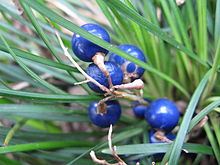- Ophiopogon japonicus
-
Ophiopogon japonicus 
Fruit, close-up Scientific classification 
Kingdom: Plantae clade: Angiosperms clade: Monocots Order: Asparagales Family: Asparagaceae Subfamily: Nolinoideae Genus: Ophiopogon Species: O. japonicus Binomial name Ophiopogon japonicus
(L.f.) Ker Gawl.Ophiopogon japonicus (Mondo grass, Fountain plant, monkey grass; Japanese: リュウノヒゲ ryu-no-hige ("dragon's beard") or ジャノヒゲ ja-no-hige ("snake's beard") is a species of Ophiopogon native to Japan.
Contents
Growth
It is an evergreen, sod-forming perennial plant. The leaves are linear, 20–40 cm long. The flowers are white to pale lilac, borne in a short raceme on a 5–10 cm stem. The fruit is a blue berry 5 mm diameter.[1] The roots are large stolens with tuberous roots.[2]
Medicinal uses
In Chinese medicine Ophiopogon japonicus tuber, known as mai men dong (Chinese: 麥門冬), is the cardinal herb for yin deficiency. According to the Chinese Herbal Medicine Materia Medica, the herb is sweet, slightly bitter and slightly cold, enters the Heart, Lung and Stomach channels and nourishes the yin of the Stomach, Spleen, Heart and Lungs and clears heat and quiets irritability. It is used for hacking dry coughs, dry tongue and mouth and constipation. Liriope spicata is used as a substitute.[3]
Characteristics
It is also grown as an ornamental plant, providing an excellent groundcover. Several cultivars have been selected, including 'Albus' (white flowers), 'Compactus' and 'Kyoto Dwarf' (dwarf forms, not over 4–5 cm tall), and 'Silver Mist' (variegated, with white-striped leaves). It is often sold as a decorative plant for freshwater aquaria, but because it is not a true aquatic plant, it may flourish for a few months and then die. While hardy to temperatures of about -20 °C when dormant in winter outdoors in normal soil, when kept fully submerged it requires water temperatures of 18-25 °C. It grows well in full sun or partial shade. Propagation is from side shoots.[1][4]
Gallery
See also
Liriope muscari - also commonly called monkey grass
References
- ^ a b Huxley, A., ed. (1992). New RHS Dictionary of Gardening. Macmillan ISBN 0-333-47494-5.
- ^ Brown, D., (1995) "The Royal Horticultural Society encyclopedia of herbs and their uses". ISBN 1-4053-0059-0
- ^ Chinese Herbal Medicine Materia Medica Third Edition by Daniel Bensky, Steven Clavey, Erich Stoger and Andrew Gamble. Eastland Press, 2004
- ^ Hiscock, P. (2003). Encyclopedia of Aquarium Plants. Interpret Press.
Categories:- Nolinoideae
- Flora of Japan
- Medicinal plants
- Plants used in Traditional Chinese medicine
- Garden plants of Asia
- Groundcovers
- Grasses
Wikimedia Foundation. 2010.




